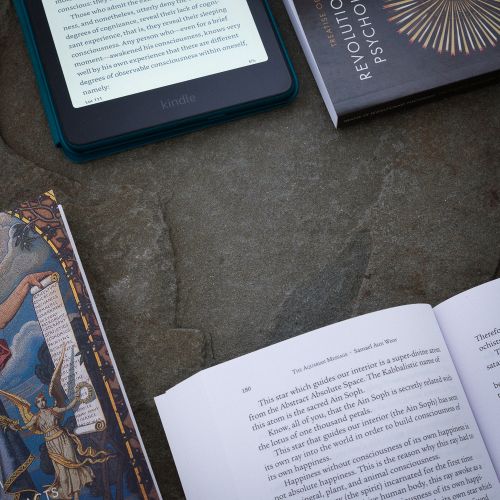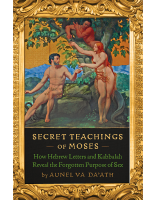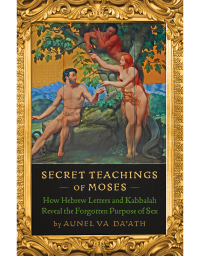In the Tree of Life we study four worlds. These four worlds are:
- Atziluth אצילות, the world of Archetypes or Emanations, the level of potentialities or "blueprints." Example: In the sperm and ovum are the possibilities or archetypes of a child.
- Briah בריאה, the world of Creation. Example: the father and mother unite sexually and the embryo of a human being is created.
- Yetzirah יצירה, the world of Formation. Example: the child is formed in the womb for nine months.
- Assiah עשיה, the world of matter. Example: the child is born into the physical world.
Atziluth is the world of archetypes where we find all the elements of creation in chaos, or as the Bible explains it:
And the earth was without form, and void. —Genesis 1:2
This means that these elements are not yet shaped, or in a concrete form; that is the meaning of “without form, and void.”
Atziluth, the world of archetypes, is a perfect world where in the philosophical sense we do not find any evil. Everything is positive. The world of Atziluth is the world of God, which we always relate to the three Sephiroth that we find atop the Tree of Life: Kether כתר, Chokmah חכמה, and Binah בינה.
In all of these four worlds we find the ten Sephiroth expressed as we see them in the Tree of Life. Thus, in the world of Atziluth—which is represented by the three primary forces: Kether, Chokmah and Binah—we find the rest of the Sephiroth. So, there are ten spheres (Sephiroth) in which we find the names of God, or Gods, in different ways.
Some translations of the Bible changed all divine names to merely “Jehovah” or just “God.” Yet, the original Hebrew has many names for God. When you read the scripture, you need to know exactly which name was written there by Moses, so you know how the scripture corresponds to the Tree of Life.
The following ten names are all related to the world of Atziluth.
- In the first Sephirah, Kether כתר, the name of God is אהיה אשר אהיה [Eheieh Asher Eheieh]. “I am that I am.” When Moses asked Kether, “What is the name that I should tell the people?” Kether answered: “I am that I am.” [Exodus 3:14] However, we have to say “He is the One that is.” By knowing the name of God written in the scripture, we know that what is being taught there is related with Kether, the first Sephirah.
- In the second Sephirah, Chokmah חכמה, the name of God is יהוה [Iod-Hei-Vav-Hei; Iod Heva]. In the Old Testament, this is usually translated as Jehovah. It relates to the Christ as the Son.
- In the third Sephirah, Binah בינה, the name of God is יהוה אלהים [Jehovah Elohim]. Adam and Eve were created by Jehovah Elohim, the Holy Spirit.1 It is the Sexual force manifested in God.
- In the fourth Sephirah, Chesed חסד, the name of God is אל [El]. Chesed means love, mercy. אל [El] means “God”; that is, our own particular Spirit, our Innermost who emerges from the Holy Trinity (Kether, Chokmah, Binah). El is the Monad. Within “El” the Monad are the three atoms: the atoms of the Father, Son, Holy Spirit. “El,” the Monad, has cosmic consciousness, which is:
- The fifth Sephirah, Geburah גבורה. Here, the name of God is רובג םיהלא Elohim Gibor, which means “the might of the Gods and Goddesses,” which is the Sephirah Geburah. Geburah means “severity.” When Elohim Gibor is in the Initiate, he/she is a warrior.
- In the sixth Sephirah, Tiphereth תפארת, the name of God is אלוה ו דעת יהוה [Eloah va Daath Iod-Hei-Vav-Hei], which means “Goddess, and knowledge of Iod-Havah,” or “These, and the knowledge of Iod-Havah.”
- In the seventh Sephirah, Netzach נצח, the name of God is יהוה צבאות [Jehovah Sabbaoth, or Iod Heva Sabbaoth]. Sabbaoth means “host or army.” Jehovah Sabbaoth is the “Army of Jehovahs.”
- In the eighth Sephirah, Hod הוד, the name of God is אלהים צבאות [Elohim Sabbaoth], which means “Army of Gods and Goddesses.” Elohim Sabbaoth is the name of God in the Astral Plane.
- In the ninth Sephirah, Yesod יסוד, the name of God is שדי אל חי [Shaddai El Chai], which means “The Almighty Living God,” which is the sexual force. Chai חי is a singular Hebrew word for “creature.” Chaioth חיות is plural, meaning “creatures.” God spoke to Moses, “When I made my pact with Abraham, the pact with man, I appeared as Shaddai El Chai, but to you I appear as Jehovah.”
- In the tenth Sephirah, Malkuth מלכות, the name of God is אדני [Adonai], “Lord.”
These names are very important to understand because they indicate which aspect of the Tree of Life is involved. For this reason, it is valuable to have a Bible with the original Hebrew letters.
Moreover, the translations of the Bible are filled with changes to the original words. For example, in the second chapter of Genesis, the translators of the Bible put “the Lord God” instead of the name that is written in Hebrew: Jehovah Elohim. In Hebrew, the four-lettered name of God יהוה, or Jehovah, is never spoken, and is replaced by Adonai אדני, or “Lord.” Adonai is the name of God related to the Sephirah Malkuth, at the very bottom of the Tree of Life. Thus, if one relies on the translations to read the names, one will make mistakes. To understand the Bible, one needs to be able to recognize the Hebrew letters, and be familiar with the Tree of Life.
Every single name of God in Atziluth implies the function of God within that Sephirah upon the Tree of Life. Thus, when we read in the Bible “Jehovah Elohim,” we immediately know this is the action of the Sephirah Binah.







